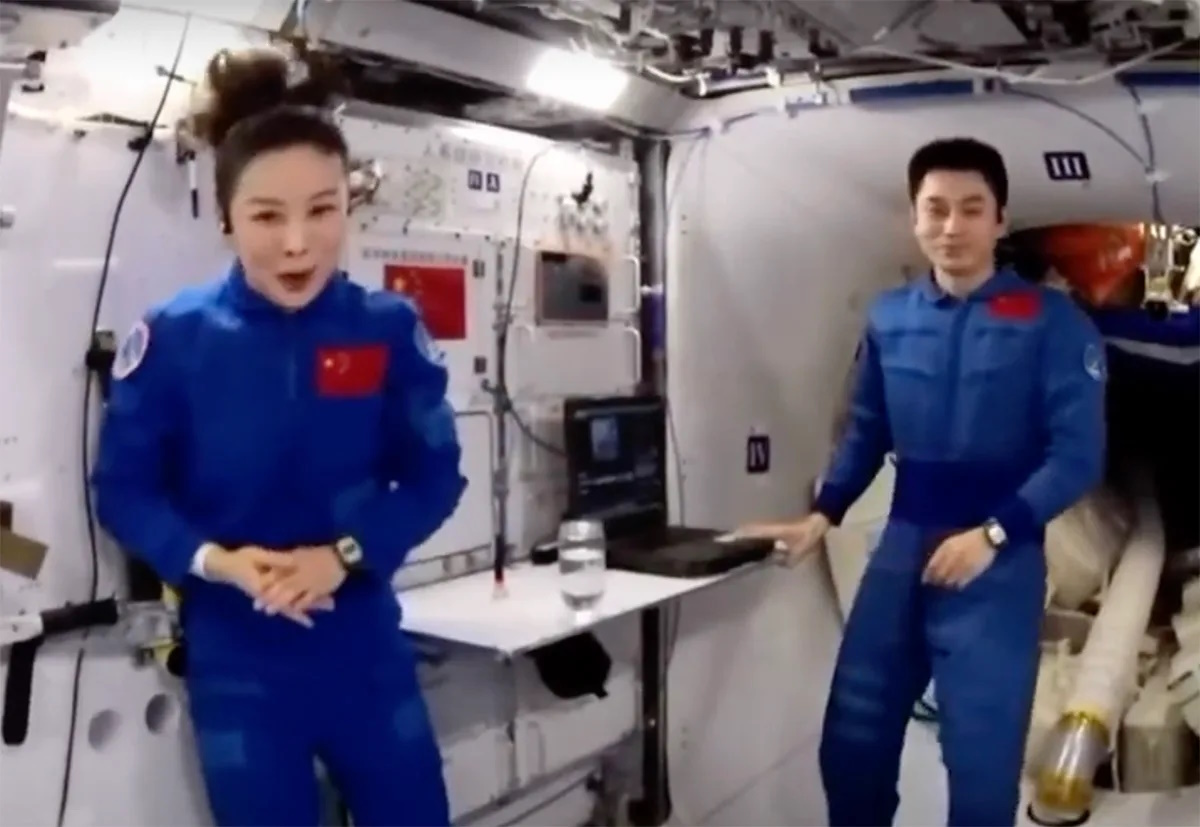A seemingly innocuous detail in a video broadcast from China’s Tiangong space station ignited a surprising debate. The footage, part of a live-streamed science lesson, showcased a glass of clear liquid sitting unperturbed on a table aboard the Chinese orbital outpost.
This sight immediately sparked skepticism among some viewers, leading to accusations that the video was fake and that China was attempting to deceive the world about its space capabilities. The core of the criticism centered on a fundamental misunderstanding of physics: given a weightless environment, why wasn’t the water floating out of the glass? And, for that matter, why wasn’t the glass itself floating away?
These questions arose from a common misconception derived from popular portrayals of space, where liquids often appear as free-floating spheres. Indeed, we’ve all seen compelling videos of astronauts on the International Space Station (ISS) demonstrating how water behaves in microgravity, often forming mesmerizing, globular displays. This perceived discrepancy fueled the “faked video” theory.
However, scientific principles, supported by expert analysis and direct evidence, thoroughly debunk these claims, offering a deeper understanding of how liquids truly behave in the unique environment of space.
The Origin of the Theory: A Moment in the Limelight
The controversial glass of water first appeared during a highly anticipated event: a live-streamed science lesson conducted by the Shenzhou-13 crew from the Chinese Tiangong space station in late 2021. This educational broadcast was intended to share scientific demonstrations and insights into life in orbit with students and the public on Earth.
Sparking Online Speculation
The sight of the stable glass of water quickly caught the attention of online commentators. This prompted a wave of discussion, with some individuals questioning whether this was a case of “catastrophic oversight” by the Chinese space agency.
These critics suggested that the agency was attempting to “trick the rest of the world into believing it had a sophisticated space program,” implying a level of deception that would undermine China’s significant achievements in space exploration. The underlying assumption was that water must float freely in microgravity, and its stability in the glass was therefore irrefutable proof of a terrestrial setup.
The Associated Press Steps In
Recognizing the widespread nature of this misinformation, the Associated Press (AP), as part of its ongoing effort to “address widely shared misinformation,” decided to investigate the physics behind the phenomenon. They consulted with experts to provide a scientifically accurate explanation, effectively cutting through the speculation and conspiracy theories. Their thorough approach aimed to clarify the scientific reality for the public, using expert insights to counter unsubstantiated claims.
Debunking the Theory: The Science of Microgravity Water
The key to understanding why water remained in the glass lies in fundamental principles of fluid dynamics in a microgravity environment.
The Role of Surface Tension and Adhesion
The Associated Press consulted Jordan Bimm, a postdoctoral researcher and space historian at the University of Chicago, who provided a clear and concise scientific explanation. He explained that in a weightless environment, liquid in a glass tends to cling rather than drift.
Bimm elaborated, “Water molecules like to stick to glass and also to other water molecules more than they like to disperse in the air. So if there is no external force, water remains in ‘clumps’ in the weightless environment, and in this case inside the glass.” This phenomenon is primarily governed by two forces:
- Adhesion: The attractive forces between water molecules and the molecules of the glass container. Water molecules are highly polar and readily form hydrogen bonds with the silicate molecules in glass.
- Cohesion: The attractive forces between water molecules themselves, which are very strong due to hydrogen bonding.
In the absence of significant gravitational force, these intermolecular forces become dominant. On Earth, gravity constantly pulls water downwards, overcoming surface tension and adhesion in an open container. In microgravity, however, gravity is effectively neutralized, allowing these weaker but ever-present forces to dictate the water’s behavior.
This means the water adheres to the inner surface of the glass and coalesces due to its own cohesive properties, preventing it from simply floating out. Bimm further stated that surface tension “works to help maintain the static shape and presents the illusion of how water would act on the ground.” Surface tension acts like a thin, elastic skin on the water’s surface, holding it together.
Behind the Scenes: Chinese Space Program’s Demonstrations
Beyond scientific explanation, the Chinese crew itself provided visual proof and further experiments to illustrate the principles at play.
Visual Evidence of Stability
In a direct response to the online accusations, China’s crewed space program posted a “behind-the-scenes” video on the social media network Weibo. This video clearly showed astronaut Wang Yaping carefully pouring water into the glass through a straw. This method of filling is common in microgravity to control liquid flow.
Crucially, the video also revealed that the glass was secured with adhesive strips to the work surface. This simple but effective measure prevented the glass itself from floating away, as might be expected in a weightless environment. The video therefore demonstrated that the setup was not a trick, but a practical application of physics and safety protocols in space.
The Ping-Pong Ball Experiment: Debunking Buoyancy
To further illustrate the unique physics of microgravity, the Shenzhou-13 crew performed a clever follow-up experiment. They submerged a ping-pong ball in the water within the glass. The outcome provided compelling proof of the true conditions on the space station. On Earth, a ping-pong ball, being less dense than water, would immediately float to the surface due to buoyancy. However, in the weightless environment of the space station, the ball remained perfectly suspended underwater.
This is because buoyancy, which relies on a gravitational force to create a difference in pressure and displace fluid, effectively does not exist in microgravity. Without gravity, there is no “up” or “down” for the less dense object to float towards. This simple yet profound demonstration served as further proof that the physics observed in the video precisely matched what one would expect to happen in space, rather than on Earth. It directly countered the claims of fakery by showing a phenomenon impossible to replicate under normal terrestrial gravity.
Independent Verification and China’s Space Prowess
The authenticity of the Tiangong space station and the video has also been independently verified, solidifying China’s legitimate standing in space exploration.
Expert Endorsement of Authenticity
Molly Silk, a doctoral researcher at the University of Manchester in the UK, who has dedicated her studies to the Chinese space program, also weighed in on the video’s authenticity during an interview with the Associated Press. She unequivocally stated, “It is extremely unlikely that the video was faked, as Chinese space program actors have very little reason to fake a video.”
Her rationale is grounded in the reality of international space cooperation and observation. Silk further emphasized that “The presence of the space station has been verified by international actors, including China’s biggest space competitor the US.” This is a crucial point; major spacefaring nations, including the United States, meticulously track objects in Earth orbit. The Tiangong space station is regularly observed by independent entities and confirmed to be a functioning orbital laboratory. Faking its existence or operations would be an impossible task given the extensive global surveillance of space.
China’s Proven Track Record in Space
Indeed, there is no factual basis to doubt that China possesses a highly sophisticated space program. This comes as no surprise, considering the immense size and population of the country, coupled with its well-established technological prowess and significant investment in scientific advancement. Over the past decades, China has steadily built and demonstrated a comprehensive array of space capabilities. Its achievements include independent human spaceflight, satellite navigation systems, Earth observation capabilities, and ambitious lunar and planetary exploration missions.
Recent successes by the Chinese space agency further underscore its advanced capabilities and legitimate presence in space. A prime example is the recent Chang’e 6 mission, which achieved the groundbreaking feat of returning samples from the far side of the Moon. This was a technically complex mission, requiring advanced robotics, precise landing capabilities in unexplored terrain, and a sophisticated relay satellite system (Queqiao-2) to maintain communication with Earth.
Such a mission is a testament to genuine, high-level space engineering and operation, making the notion of faking a simple in-orbit video seem utterly illogical and redundant. The scientific evidence and China’s proven space achievements collectively refute the conspiracy theories, solidifying the Tiangong space station as a legitimate and active player in humanity’s ongoing exploration of space.








